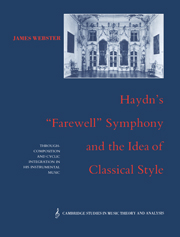 Haydn's 'Farewell' Symphony and the Idea of Classical Style
Haydn's 'Farewell' Symphony and the Idea of Classical Style Book contents
- Frontmatter
- Contents
- Foreword by Ian Bent
- Preface
- Author's note
- List of abbreviations
- Introduction
- PART I THE FAREWELL SYMPHONY
- PART II CYCLIC ORGANIZATION IN HAYDN'S INSTRUMENTAL MUSIC
- 5 Progressive form and the rhetoric of instability
- 6 Integration of the cycle
- 7 Extramusical associations
- 8 Individual compositions
- Historiographical conclusion: Haydn's maturity and “Classical style”
- Bibliography
- Index
5 - Progressive form and the rhetoric of instability
Published online by Cambridge University Press: 28 January 2010
- Frontmatter
- Contents
- Foreword by Ian Bent
- Preface
- Author's note
- List of abbreviations
- Introduction
- PART I THE FAREWELL SYMPHONY
- PART II CYCLIC ORGANIZATION IN HAYDN'S INSTRUMENTAL MUSIC
- 5 Progressive form and the rhetoric of instability
- 6 Integration of the cycle
- 7 Extramusical associations
- 8 Individual compositions
- Historiographical conclusion: Haydn's maturity and “Classical style”
- Bibliography
- Index
Summary
The through-composed character of the Farewell Symphony calls into question the traditional notion that strongly integrated multimovement instrumental cycles were more or less unknown until Beethoven. Moreover, for all its uniqueness, it is not an isolated case. Other Haydn works exhibit nearly as great a degree of throughcomposition; many individual techniques found in the Farewell are actually common in his music. Part II of this study examines the nature and extent of Haydn's integration of the instrumental cycle. In this chapter, I consider his tendency towards progressive, non-symmetrical form in individual movements – not only a characteristic feature of his art in its own right, but also of fundamental importance for through-composition on a larger scale. In the central sections of this chapter, I focus on the symphony and on the years c. 1765–74: that is, the immediate chronological and generic context of the Farewell itself, including Haydn's expressive period known under the rubric “Sturm und Drang.” (In this connection, I have divided his symphonies through 1774 into chronological groups and subgroups, as indicated in Table 5.1.)
GESTURE AND RHETORIC
Owing to the ideology of “Classical style” (see the concluding chapter), the Haydn literature has focused too much on form-as-shape (balance, symmetry, sonata form, the metaphors of architecture), and too little on form-as-process – the dynamic development of musical ideas in time – as described with respect to the music of later periods by authors such as Ernst Kurth and B. V. Asaf'ev.
- Type
- Chapter
- Information
- Haydn's 'Farewell' Symphony and the Idea of Classical StyleThrough-Composition and Cyclic Integration in his Instrumental Music, pp. 123 - 173Publisher: Cambridge University PressPrint publication year: 1991


